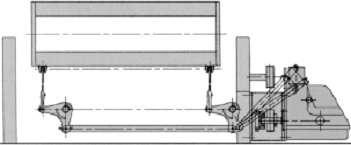Shedding in Weaving machines
The angle which is formed by the raising threads with the threads remaining in low position is called shed. The shed must be as wide open as to permit the easy passage of the weft insertion element. The shed can be obtained by either moving the heald frames or by directly moving the heald frames through. The machines used to form the shed are cam machines, dobbies, and Jacquard machines.
The angle which is formed by the raising threads with the threads remaining in low position is
called shed; the shed must be as wide open as to permit the easy passage of the weft insertion
element.
The shed can be obtained in two different ways:
- by moving the heald frames, the healds of which are crossed by the warp threads according to a pre-established drawing-in;
- by moving directly the healds through which one or several independent threads pass (figured or Jacquard weaving).
The machines used to form the shed are cam machines, dobbies, and Jacquard machines.
Cam shedding or base weave machines
This kind of machine is employed for all fabrics produced with base weaves which have a pattern
a repeat of 10-12 threads and maximum 6-8 wefts.
These machines can operate either with positive or negative shaft motion. The principle of positive
motion involves that the shafts are raised as well as lowered driven by cams. The negative motion
instead implies the motion of the shafts either in the upwards stroke or in the downwards stroke,
while the backward movement is obtained through springs. The positive shaft motion has a
conjugated structure which permits to control the shaft during all processing phases and to
minimize vibrations, thus making cams suitable for any working load at high speeds.
Operation of a cam machine (positive motion)

This machine has conjugated cams fastened on a central shaft; the two profiles are read by small wheels mounted idle on a roller lever connected at its end with the heald frame rods.
The two cams are mutually complementary so that when a cam presents its maximum
eccentricity, the other cam presents the minimum eccentricity. This characteristic permits to push
upwards the right wheel and at the same time to produce the same movement with the left wheel but in the opposite direction.

The displacement of the roller lever causes the raising of the shaft.
In the case of balanced weaves, i.e. plain weave, twill weave, diagonal 2/2, the two cams are
identical, but have each towards the other a phase angle which is established already during their construction.
For the production of the remaining weaves, the overturning of the two cams permits to obtain the opposite effect, e.g. changing over from warp to weft twill.
The cam units are as many as the working heald frames and the shaft modifies its running speed
according to the weave to be produced, consequently, he speed corresponds to the revolution
number of the machine/n and the figure 360/n shows the angle at which a weft of the repeat is
inserted (n corresponds to the number of repeat wefts).
Dobbies
Dobbies are used for the production of plain or flat fabrics, that is of fabrics characterized by
maximum 28-32 threads in the weave repeat.
Dobbies can be divided into:
According to the working principle:
- Hattersley dobbies
- rotary dobbies
The Hattersley dobbies are dobbies which control the movement of the heald frames through rods and rocker levers. The rotary dobbies attain the raising and lowering of the heald frame through rotating members.
According to the raising motion of the heald frames:
- dobbies with positive drive
- dobbies with negative drive
According to the card reading system:
- dobbies with endless pattern card
- dobbies with magnetic card
Jacquard machines
The name Jacquard machines originates from the designer who improved its operation; today the name ″Jacquard″ is used to identify all machines with a capacity higher than 28-32 threads, which are therefore used to produce figured fabrics.
The indication of the capacity of the machine, which in the past was used to differentiate the
various machine models, has today no significance, as the hook number is no more strictly related to the mechanical structure of the machine.
Jacquard machines were initially classified as follows:
- Jacquard machines
- Vincenzi machines
- Verdol machines
At present only Verdol machines and electronic Jacquard machines are still on the market.
Jacquard machines can be classified as follows:
According to card reading system:
- dobbies with endless pattern card reading system
- dobbies with electronic reading system
Electronic Jacquard
In these machines the traditional hooks have been replaced by electro-mechanically operated
modules which are driven and controlled by an electronic program. The Jacquard machines available
on the market are double lift machines and have in respect to mechanical Jacquard machines following advantages:
- easy maintenance owing to following reasons:
- no point needing lubrication,
- few moving parts
- modular construction and thus easy access;
- low vibration even at high speed;
- reduced setting time, as the machine is electronically controlled and therefore no paper is needed.
Operation principle of a dobby
Today the rotary dobby is, from the technological point of view, the most advanced dobby
available on the market.
It consists of a central shaft on which the driving bars are positioned. On a follower ring, an eccentric plate is mounted; the plate is constrained within a block which is pivoted with the control levers of the rods.
Under normal working conditions, that is with the heald frames in bottom position, there is no
the connection between the follower ring and the plate; the connection can be obtained by inserting a slider which runs in proper guides.
The central shaft is driven by a modulator which has two stop times situated each other at 180
degrees ; at this very moment the key can be controlled according to the design to be produced.


